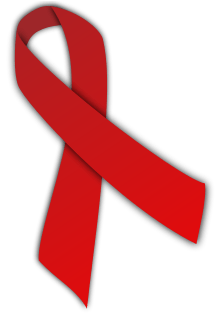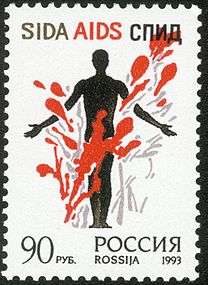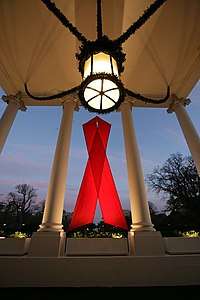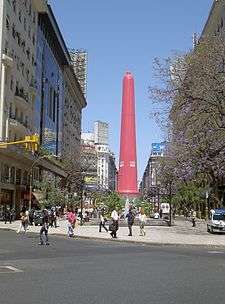World AIDS Day
World AIDS Day, designated on 1 December every year since 1988,[1] is an international day dedicated to raising awareness of the AIDS pandemic caused by the spread of HIV infection and mourning those who have died of the disease. Government and health officials, non-governmental organizations, and individuals around the world observe the day, often with education on AIDS prevention and control.
| World AIDS Day | |
|---|---|
 The red ribbon is the global symbol for solidarity with HIV-positive people and those living with AIDS. | |
| Observed by | All UN Member States |
| Date | 1 December |
| Frequency | Annual |
| First time | 1988 |
World AIDS Day is one of the eight official global public health campaigns marked by the World Health Organization (WHO), along with World Health Day, World Blood Donor Day, World Immunization Week, World Tuberculosis Day, World No Tobacco Day, World Malaria Day and World Hepatitis Day.[2]
As of 2017, AIDS has killed between 28.9 million and 41.5 million people worldwide, and an estimated 36.7 million people are living with HIV,[3] making it one of the most important global public health issues in recorded history. Thanks to recent improved access to antiretroviral treatment in many regions of the world, the death rate from AIDS epidemic has decreased since its peak in 2005 (1 million in 2016, compared to 1.9 million in 2005).[3]
History

World AIDS Day was first conceived in August 1987 by James W. Bunn and Thomas Netter, two public information officers for the Global Programme on AIDS at the World Health Organization in Geneva, Switzerland.[4][5] Bunn and Netter took their idea to Dr. Jonathan Mann, Director of the Global Programme on AIDS (now known as UNAIDS). Dr. Mann liked the concept, approved it, and agreed with the recommendation that the first observance of World AIDS Day should be on 1 December 1988.[6] Bunn, a former television broadcast journalist from San Francisco, had recommended the date of 1 December that believing it would maximize coverage of World AIDS Day by western news media, sufficiently long following the US elections but before the Christmas holidays.[6]
In its first two years, the theme of World AIDS Day focused on children and young people. While the choice of this theme was criticized at the time by some for ignoring the fact that people of all ages may become infected with HIV, the theme helped alleviate some of the stigma surrounding the disease and boost recognition of the problem as a family disease.[7]
The Joint United Nations Programme on HIV/AIDS (UNAIDS) became operational in 1996, and it took over the planning and promotion of World AIDS Day.[7] Rather than focus on a single day, UNAIDS created the World AIDS Campaign in 1997 to focus on year-round communications, prevention and education.[7][8] In 2004, the World AIDS Campaign became an independent organization.[7][8][9]
Each year, Popes John Paul II and Benedict XVI have released a greeting message for patients and doctors on World AIDS Day.[10][11][12][13][14]
In 2016, a collection of HIV and AIDS related NGOs (including Panagea Global AIDS and The AIDS and Rights Alliance for Southern Africa) started a campaign to rename World AIDS Day to World HIV Day. They claim the change will put the emphasis on social justice issues, and the advancement of treatments like PrEP.[15]
In the US, the White House began marking World AIDS Day with the iconic display of a 28 foot (8.5 m) AIDS Ribbon on the building's North Portico in 2007.[16][17] White House aide Steven M. Levine, then serving in President George W. Bush's administration, proposed the display to symbolize the United States' commitment to combat the world AIDS epidemic through its landmark PEPFAR program.[18] The White House display, now an annual tradition across four presidential administrations, quickly garnered attention, as it was the first banner, sign or symbol to prominently hang from the White House since the Abraham Lincoln administration.[19][20][21]
Since 1993, the President of the United States has made an official proclamation for World AIDS Day (see section #US Presidential Proclamations for World AIDS Day for copies of those proclamations). On 30 November 2017, President Donald Trump proclaimed World AIDS Day for 1 December.[22][23]
Themes
All the World AIDS Day campaigns focus on a specific theme, chosen following consultations with UNAIDS, WHO and a large number of grassroots, national and international agencies involved in the prevention and treatment of HIV/AIDS. As of 2008, each year's theme is chosen by the Global Steering Committee of the World AIDS Campaign (WAC).[7]
For each World AIDS Day from 2005 through 2010, the theme was "Stop AIDS. Keep the Promise", designed to encourage political leaders to keep their commitment to achieve universal access to HIV/AIDS prevention, treatment, care and support by the year 2010.[7]
As of 2012, the multi-year theme for World AIDS Day is "Getting to Zero: Zero new HIV infections. Zero deaths from AIDS-related illness. Zero discrimination."[24] The US Federal theme for the year 2014 is "Focus, Partner, Achieve: An AIDS-Free Generation".[25]
The themes are not limited to a single day but are used year-round in international efforts to highlight HIV/AIDS awareness within the context of other major global events including the G8 Summit, as well as local campaigns like the Student Stop AIDS Campaign in the UK.
World AIDS Day themes
Source:[26]


| 1988 | Communication | ||
| 1989 | Youth | ||
| 1990 | Women and AIDS | ||
| 1991 | Sharing the Challenge | ||
| 1992 | Community Commitment | ||
| 1993 | Time to Act | ||
| 1994 | AIDS and the Family | ||
| 1995 | Shared Rights, Shared Responsibilities | ||
| 1996 | One World. One Hope. | ||
| 1997 | Children Living in a World with AIDS | ||
| 1998 | Force for Change: World AIDS Campaign With Young People | ||
| 1999 | Listen, Learn, Live: World AIDS Campaign with Children & Young People | ||
| 2000 | AIDS: Men Make a Difference | ||
| 2001 | I care. Do you? | ||
| 2002 | Stigma and Discrimination | ||
| 2003 | Stigma and Discrimination | ||
| 2004 | Women, Girls, HIV and AIDS | ||
| 2005 | Stop AIDS. Keep the Promise | ||
| 2006 | Stop AIDS. Keep the Promise – Accountability | ||
| 2007 | Stop AIDS. Keep the Promise – Leadership | ||
| 2008 | Stop AIDS. Keep the Promise – Lead – Empower – Deliver[27] | ||
| 2009 | Universal Access and Human Rights[28] | ||
| 2010 | Universal Access and Human Rights[28] | ||
| 2011 | Getting to Zero[29] | ||
| 2012 | Together we will end AIDS [30] | ||
| 2013 | Zero Discrimination[31] | ||
| 2014 | Close the gap[32] | ||
| 2015 | On the fast track to end AIDS[33] | ||
| 2016 | Hands up for #HIVprevention[34] | ||
| 2017 | My Health, My Right[35] | ||
| 2018 | Know your status[36] | ||
| 2019 | Communities make the difference[37]
|
See also
- AIDS Awareness Week
- National AIDS Testing Day (United States)
- Epidemiology of HIV/AIDS
- World Health Day
- World Hepatitis Day
- World Cancer Day
- Day Without Art
- HIV.gov
- World AIDS Vaccine Day
- World Rabies Day
References
- "About World Aids Day". worldaidsday.org. National Aids Trust. Retrieved 4 December 2014.
- World Health Organization, WHO campaigns.
- Fact sheet - Latest statistics on the status of the AIDS epidemic UNAIDS. Accessed 30 November 2017.
- "NPR: How World AIDS Day Began".
- U.S. Centers for Disease Control and Prevention, International News, "World AIDS Day Co-Founder Looks Back 20 Years Later", CDC HIV/Hepatitis/STD/TB Prevention News Update, 12 December 2007
- "Inventors of World AIDS Day: James Bunn and Thomas Netter".
- Speicher, Sara (19 November 2008). ""World AIDS Day Marks 20th Anniversary Of Solidarity."". Medical News Today. Medicalnewstoday.com. Retrieved 5 December 2013.
- "van Soest, Marcel. "Accountability: Main Message on World AIDS Day." Joint United Nations Programme on HIV/AIDS. 20 Oct 2006". Unaids.org. 20 October 2006. Archived from the original on 4 December 2009. Retrieved 5 December 2013.
- Yearbook of the United Nations 2005. Vol. 59. Geneva, Switzerland: United Nations Publications, 2007. ISBN 92-1-100967-7
- "First World AIDS Day in 1988". Vatican.va. Retrieved 5 December 2013.
- Message for the World AIDS Day Archived 4 March 2016 at the Wayback Machine
- Gheddo, Piero. "Pope: "I feel near to people with AIDS and their families"". Asianews.it. Retrieved 5 December 2013.
- Message of Caritas Internationalis On Occasion of World AIDS Day 2006
- Pullella, Philip. "Pope skirts condoms issue in World AIDS Day statement". Blogs.reuters.com. Retrieved 5 December 2013.
- "The World Has Changed: The HIV Response Must Change Too On World HIV Day".
- Jennifer Parker (30 November 2007). "Two-Story AIDS Ribbon at White House". ABC News. Archived from the original on 29 July 2013. Retrieved 1 December 2017.
- Proclamation 8207: World AIDS Day, 2007. 29 November 2007 – via Wikisource.
- "Inside George W. Bush's Closet". POLITICO Magazine. Retrieved 2 December 2017.
- "White House hangs red ribbon for World AIDS Day". Retrieved 2 December 2017.
- "The White House Honors World AIDS Day 2012". whitehouse.gov. 1 December 2012. Retrieved 2 December 2017.
- "A red ribbon adorns the North Portico of the White House Friday, Nov. 30, 2007, in recognition of World AIDS Day and the commitment by President George W. Bush and his administration to fighting and preventing HIV/AIDS in America and the world. White House photo by Eric Draper". georgewbush-whitehouse.archives.gov. Retrieved 2 December 2017.
- Office of the Press Secretary (30 November 2017). "President Donald J. Trump Proclaims December 1, 2017, as World AIDS Day". whitehouse.gov. Washington, D.C.: White House. Retrieved 1 December 2017.
- Wong, Curtis M. (30 November 2017). "Trump Excludes LGBTQ People From World AIDS Day Proclamation". HuffPost. New York City: Oath Inc. Retrieved 1 December 2017.
- World Health Organization, World Aids Day 2012: Closing in on global HIV targets. Accessed 8 April 2014
- "Aids Day 2014". ibtimes. Retrieved 1 December 2014.
- "World AIDS Day". Archived from the original on 1 December 2016. Retrieved 7 February 2016.CS1 maint: BOT: original-url status unknown (link), Minnesota Department of Health
- "Dr. Peter Piot, "2008 World AIDS Day statements", Joint United Nations Programme on HIV/AIDS (UNAIDS), 30 November 2008". UNAIDS. 30 November 2008. Archived from the original on 25 March 2009. Retrieved 5 December 2013.
- World AIDS Day avert.org
- World AIDS Day 2011 Archived 1 July 2015 at the Wayback Machine World AIDS Campaign
- World AIDS Day 2012 UNAids
- World AIDS Day 2013 UNAids
- World AIDS Day 2014 UNAids
- World AIDS Day 2015 UNAids
- World AIDS Day 2016 UNAids
- UNAIDS launches 2017 World AIDS Day campaign-right to health UNAids
- Know your HIV status UNAids
- Communities make the difference UNAids
External links
| Wikimedia Commons has media related to World AIDS Day. |
- World AIDS Day – UK site
- The World AIDS Campaign
- World AIDS Day Campaign – WHO Eastern Mediterranean Region
- World Aids Day posters from the AIDS Posters Collection – UCLA Library
- The ILO's Getting to Zero at the workplace campaign
US Presidential Proclamations for World AIDS Day

- 2015 Proclamation
- 2014 Proclamation
- 2013 Proclamation
- 2012 Proclamation
- 2011 Proclamation
- 2010 Proclamation



- 2006 Proclamation
- 2005 Proclamation
- 2004 Proclamation
- 2003 Proclamation
- 2002 Proclamation
- 2001 Proclamation

- 1999 Proclamation

- 1997 Proclamation
- 1996 Proclamation
- 1995 Proclamation

